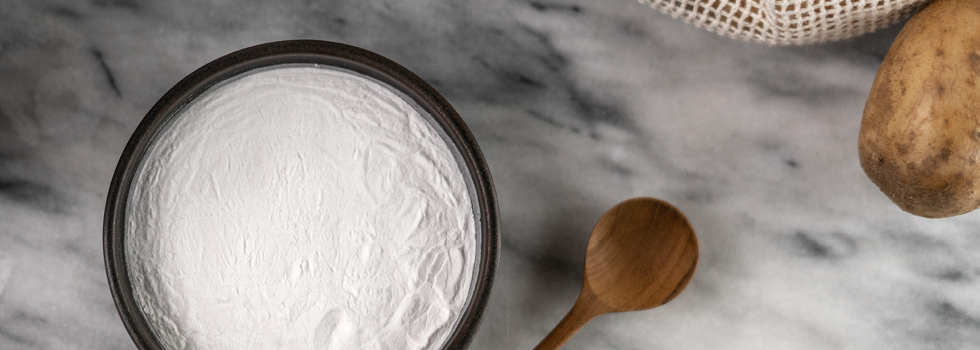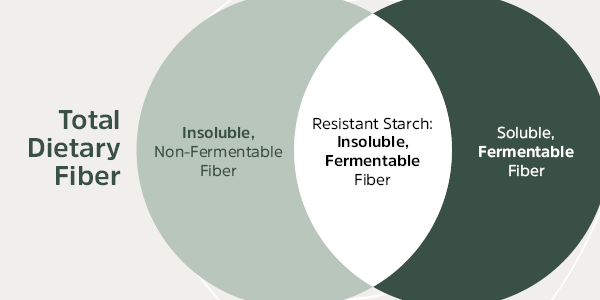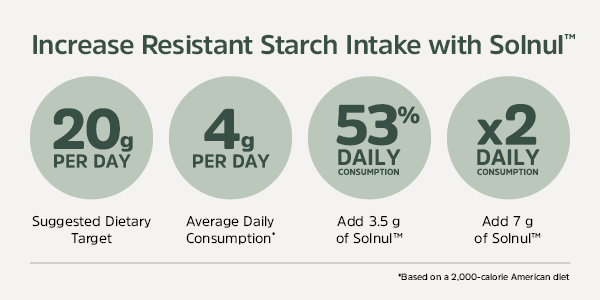Promotional Features
Getting to the Bottom of the Fiber Gap: Why Prebiotic Resistant Starch is Crucial to Digestive Health
It's undisputed that a healthy gut microbiome is integral to human's overall well-being and that fiber plays a critical role in maintaining this health. Some of fiber's many accolades include improving stool formation, regularity and blood glucose control, and encouraging beneficial bacterial growth.1 For these very reasons, we're advised by health authorities to consume "more fiber" to prevent various health conditions and diseases.2 But what happens if we're meeting our fiber targets and disease prevails? Is more fiber really the answer? Or, is it more fiber diversity?
Nutrient Dietary Targets
Australians eat more fiber than any other western country, and although only slightly below the daily fiber targets (27 grams for men and 21 grams for women),3 they still suffer from diseases affiliated with low fiber intake like colorectal cancer, among the most prominent types of cancer in Australia.4
Researchers have suggested that to achieve optimum bowel health, daily intake of resistant starch separate from dietary fiber targets needs to increase towards 20 grams per day.5
Defining fiber has been historically challenging and hasn't progressed with evolving research, with definitions often overlooking more unique types of fiber. Resistant starch is one that deserves recognition on its own separate from total dietary fiber, because it's a prebiotic that doesn't squarely fit into traditional testing methods and classifications. While most constituents include either insoluble or soluble categories, resistant starch is an insoluble fiber that ferments like soluble fiber, possessing an ambilateral effect. It's been postulated that if health authorities recommend an allowance for resistant starch in conjunction with dietary fiber, populations will see improved health outcomes.6
Resistant Starch Deficient Populations
A recent study using the NHANES database identified that the average US adult consumes roughly 4 grams of resistant starch per day through diet.7 Based on the Australian Suggested Dietary Target for resistant starch, that's only 20% of the recommended daily consumption. Other western countries are not far behind, indicating that modern diets do not provide adequate amounts of resistant starch.8 Through modern food processing and milling, resistant starch has been removed from our foods. We know this to be true because our ancestors used to consume 30 to 50 grams of resistant starch per day from raw starchy foods and whole grains and beans over 10,000 years ago.9 Today, resistant starch, specifically Resistant Starch Type 2 (RS2), is a hard to acquire nutrient on its own. This makes supplementation necessary to reach daily targets and to keep the microbiome well-fed.
The Microbiome's Favorite Food
RS2 is a natural, unmodified source of resistant starch and is the microbiome's preferred type of resistant starch.10 RS2 resists digestion and arrives in the large intestine to feed the beneficial gut bacteria through fermentation, optimizing the microbial balance. Bifidobacterium is exceptionally partial to RS2 and is a primary degrader. Increasing Bifidobacterium levels can lead to positive changes in gastrointestinal health, helping prevent colorectal cancer and other bowel diseases as well as promote regularity and reduce symptoms of diarrhea.11 Bifidobacterium also supports the immune system by suppressing unnecessary inflammation, pathogens and colonization of harmful bacteria.12 The increase in Bifidobacterium coupled with the host health benefit validates RS2 as a prebiotic. In contrast, other types like RS4, the chemically modified form of resistant starch, are not prebiotics.13
The Solnul™ Solution
Solnul™ Resistant Potato Starch (RS2) is a clinically-proven, patented ingredient used by formulators of dietary supplements and functional food and beverage. Contrary to many prebiotic fibers, Solnul™ is backed by a body of clinical and scientific research proving efficacy at low doses, exceptional tolerability and multi-functionality. It significantly increases Bifidobacterium by 350%, supports GI health and promotes regularity with as little as 3.5 grams per day.14 It labels as 'Resistant Potato Starch' and is considered a prebiotic dietary fiber. Solnul™ is certified FODMAP Friendly, Gluten-Free, Glyphosate Residue Free, Non-GMO Project Verified, and a member of the Upcycled Food Association.
As gut health continues to be the primary focus of consumer's overall health, substantiated and effective ingredients will be in demand. Formulators seek to have Solnul™ in their toolbox to enhance their product's fiber quantity and quality. With every new product launch fueled by Solnul, we're closer to bridging the fiber gap with resistant starch and restoring human health to that of our ancestors.
Learn more about the microbiome research and benefits of Solnul™ at www.solnul.com
------
References:
1 The CSIRO Healthy Gut Diet Cookbook, 2018 – Dr. Tony Bird, Dr. Michael Conlon & Pennie Taylor, Australia2,3,5,6 Landon S, Colyer C, Salman H. The resistant starch report—Food Australia Supplement 2012 Available Here4 CSIRO.au accessed here7,8,10 Patterson MA, Maiya M, Stewart ML. Resistant starch intakes in the United States: a narrative review. J Acad Nutr Diet 2020. Available Here *Based on a 2,000-calorie diet per day9 Witwer R. “Ancestral Resistant Starch.” Available Here11 O'Callaghan, A., & van Sinderen, D. (2016). Bifidobacteria and Their Role as Members of the Human Gut Microbiota. Frontiers in microbiology, 7, 925. https://doi.org/10.3389/fmicb.2016.0092512 Front. Immunol., 01 October 2019 | https://doi.org/10.3389/fimmu.2019.0234813 Deehan EC, Yang C, Perez-Muñoz ME, Nguyen NK, Cheng CC, Triador L, Zhang Z, Bakal JA, Walter J. Precision Microbiome Modulation with Discrete Dietary Fiber Structures Directs Short-Chain Fatty Acid Production. Cell Host Microbe. 2020 Mar 11;27(3):389-404.e6. doi: 10.1016/j.chom.2020.01.006. Epub 2020 Jan 30. PMID: 32004499.14 These statements have not been evaluated by the Food and Drug Administration. This product is not intended to diagnose, treat, cure, or prevent any disease.


